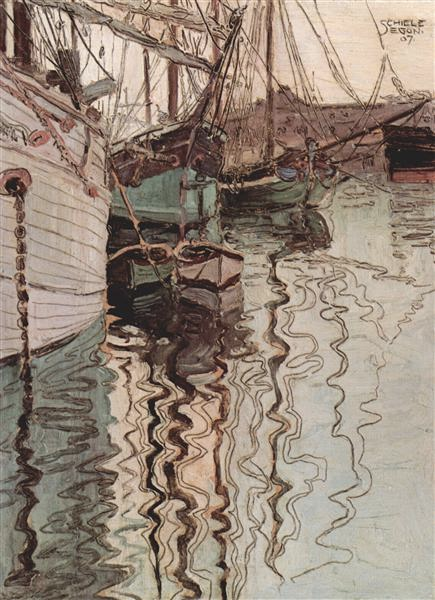An old saying goes, “Tell me, and I will forget, teach me, and I will remember, involve me, and I will learn.” Art is an excellent example of this motto, and Austrian Expressionist artist Egon Schiele is a great example of an artist who did just that.
Most artists undergo formal training before honing their style, whether life as a teacher, academic study, or apprentice under a master. However, when it comes to Egon Schiele’s life story, he underwent all three in one form or another.
Like many artists, Schiele became interested in drawing from a young age. This led to Schiele spending hours upon hours filling up sketchbooks with drawings. Eventually, his talent was recognized, and he was enrolled in art school. Soon after, Schiele became a student of renowned Austrian painter Gustav Klimt and, before long, cemented his name as the leading artist in Expressionist eroticism painting.
Harbor of Trieste (1907)
Harbor Of Trieste – Egon Schiele
Not long after enrolling in the school of fine arts in Vienna, Schiele became disillusioned with the rigid and conservative teachings promoted by the school. He became so discouraged that eventually, he dropped out of the academy entirely in pursuit of his artistic vision.
By 1907, glimpses of Schiele’s disposition for the abstract and experimental began to show themselves in some of Egon Schiele’s paintings. The Harbor of Trieste is just one example of this trend. You can take any of Schiele’s paintings from 1907 and see signs of the Expressionism style emerging.
In the harbor painting, Schiele takes the common Impressionist motif of boats and water and twists it to suit his ideals. In particular, the shadows and ripples of the water bend and warp so that it leaves the mind perplexed and marks Schiele’s transition from Impressionism to Art Nouveau.
View from the Drawing Classroom, Klosterneuburg (1905)
View From The Drawing Classroom Klosterneuburg – Egon Schiele
Practically none of Egon Schiele’s childhood sketches and drawings remain today. However, one sketchbook is said to still exist thanks to a classmate of Schiele’s who took it with them when they fled to America at the start of World War II.
However, there is some record of Egon Schiele’s art before he eventually enrolled in the Academy of Fine Arts in Vienna, where his career as an artist truly began. One such painting from this earlier time is the View from the Drawing Classroom, Klosterneuburg.
Painted in the Impressionist style popular then, this early Schiele painting showcases the young boy’s tremendous ability and potential. Although wholly conventional compared to Schiele’s later work, it is nonetheless a painting any artist would be proud of, let alone a 15-year-old child, which was the age Schiele was when he painted it.
Mother and Child (Madonna) (1908)
Mother And Child Aka Madonna – Egon Schiele
Also, in 1907, Schiele met his idol Gustav Klimt after seeking him personally. Klimt was the premier Art Nouveau artist at the time and was well known for helping out young aspiring artists. Klimt was intrigued by Schiele and his unique ideas, and the two soon became friends.
Schiele studied under Klimt for some time and was introduced to the works of many great artists, such as the famous Van Gogh and Edvard Munch, to name a few. During this time, Schiele also started to explore the idea of painting human sexuality.
The undying symbol of the Mother and Child has appeared in art for hundreds of years. Several of the most famous artists throughout history have attempted a portrayal of this sacred symbol. In Schiele’s depiction, a slightly sinister and sexual undercurrent is housed within. However, this would be just the start of things to come.
Self-Portrait with Arm Twisted Above Head (1910)
Although Schiele never met Van Gogh, the Dutch painter was a significant influence and teacher to him. Starting around this time, many of Egon Schiele’s paintings would be self-portraits; however, in typical Schiele fashion, they would be taken to a new level of bizarre.
In Schiele’s self-portrait version, he painted himself nude and, more often than not, showcased his whole body, genitals, and all. Furthermore, Schiele began experimenting with depictions of the human form, portraying them as twisted, distorted, and with a firm sexual context.
In his painting entitled Self-Portrait with Arm Twisted Above Head, Schiele depicts himself as a grossly distorted and perverted figure. Some critics have stated that one way of looking at these paintings is to represent the classical Christian idea of ‘the sinner,’ while others argue that they are a self-reflection of how the artist may have viewed himself.
Death and the Maiden (1915)
By 1915, Schiele’s individuality as an artist had been fully formed. But, like every human being, the experience of life had its effect on the artist and has proven to be the ultimate teacher. By this time, Schiele had spent some time in prison, gotten married, and World War I was in full swing.
The results of these events trickled into Egon Schiele’s art, which grew darker and grotesque. Even Schiele’s landscapes paintings of houses and urban environments hold an uncanny unease within them. This is not meant as a criticism, however, for these are some of the finest and most intriguing paintings he ever painted.
Perhaps the most profound piece from this period is his painting of Death and the Maiden. The painting can be seen as the result of all of Schiele’s education up until this point. As a result, there are shades of many artists’ influences to be found in the masterpiece. For this reason, the artwork is considered by many individuals to be Schiele’s most extraordinary painting.
Conclusion
Whether you love or hate Schiele, it cannot be denied that the artist was indeed one of a kind. As an artist who produced over 300 works, these are just some of his wonderfully weird paintings. Learning more about Egon Schiele’s art is just one click away.

